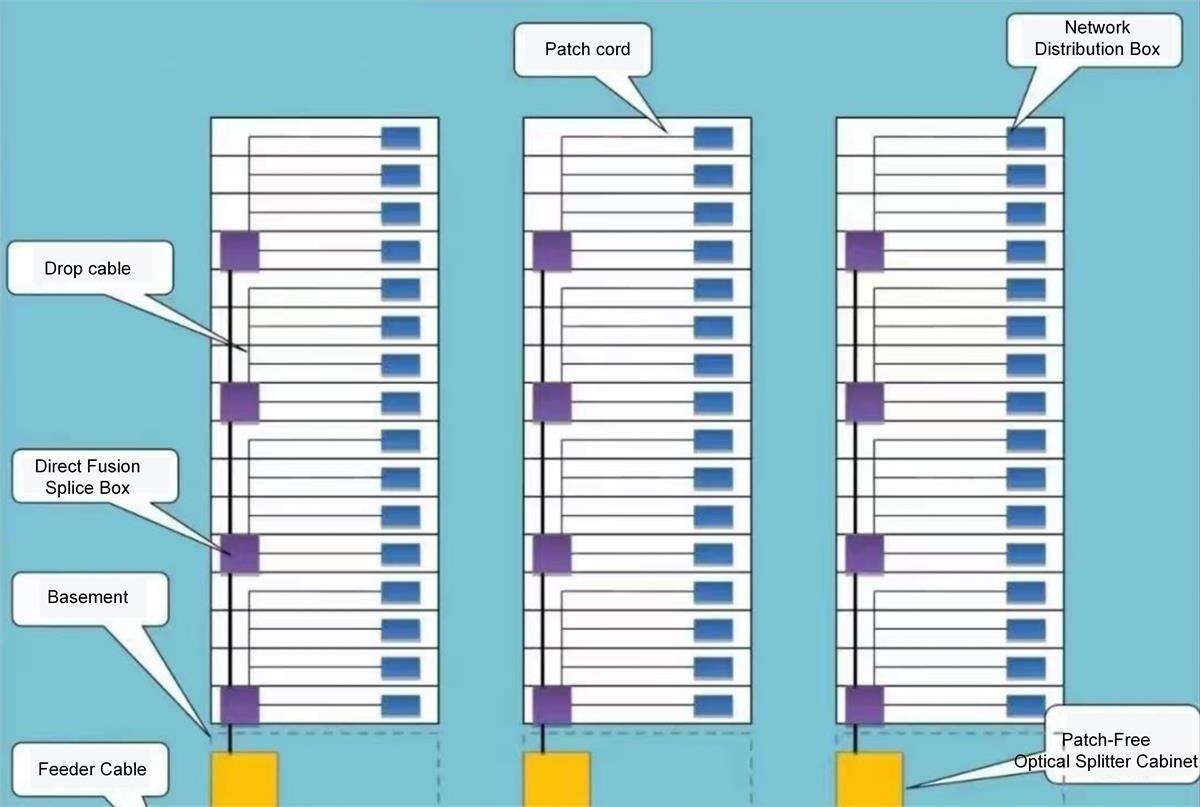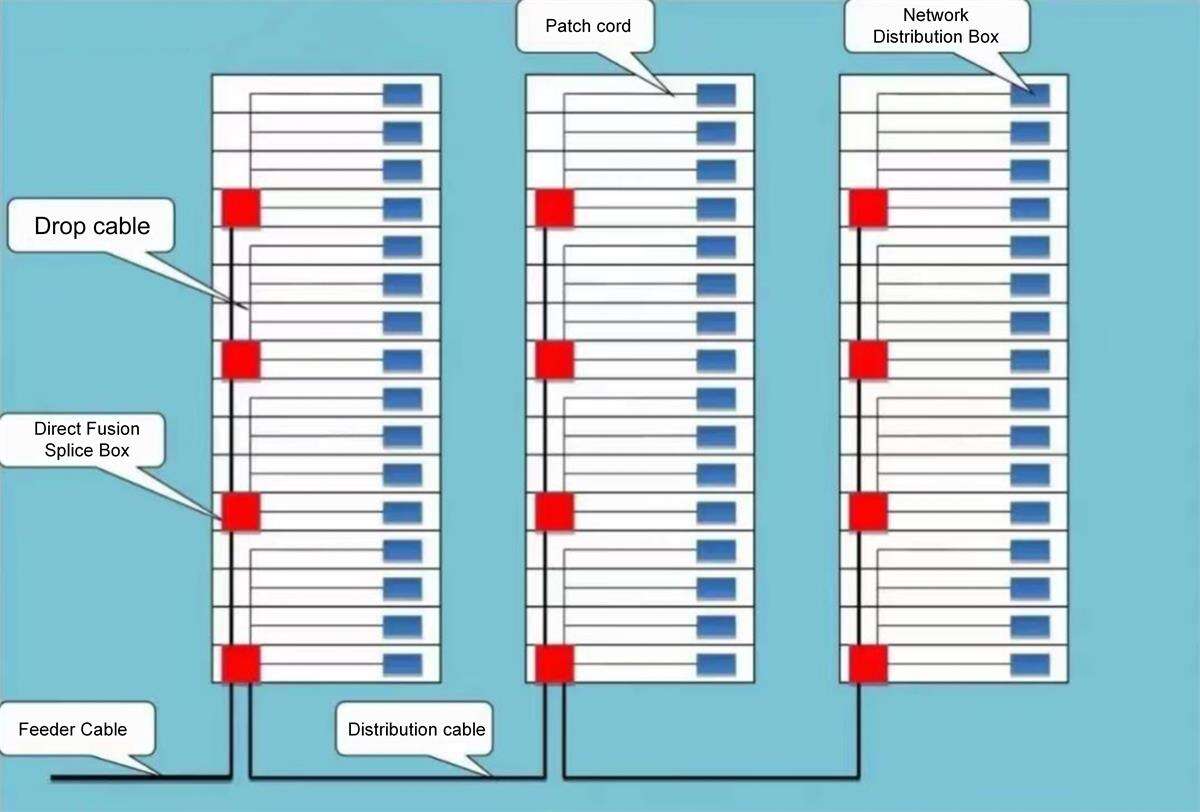FTTH
1.FTTH Construction Schemes
In China, there are two mainstream FTTH construction schemes: the Single-Level Splitting Scheme and the Dual-Level Splitting Scheme. Based on the placement of optical splitters, these can be categorized into centralized and distributed splitting. Additionally, they can be divided based on usage scenarios into multi-story building applications and high-rise building applications.
2.Single-Level Splitting Scheme
- Centralized Splitting Overview
2.1 Centralized Splitting (Multi-Story Building) Diagram


2.2 Centralized Splitting (High-Rise Building) Diagram


2.3 Design Approach
- At the OLT (Optical Line Terminal) end, a fiber distribution frame is used. Its main function is to connect optical equipment on the device side and outdoor optical cables on the line side, with jumpers connecting the line and device sides.
- At the fiber cross-connection point, a patch-free optical fiber cross-connection cabinet is used. The advantages of patch-free design include: increased capacity by doubling; reduced adapters and elimination of patch cords, reducing node and line losses; more rational and standardized line management.
- At the optical distribution point, a patch-free optical splitter box is used, with optical splitters concentrated within the box for centralized scheduling and management.
- In the hallway, a hallway direct fusion splice box is used, mainly to connect distribution optical cables from the user access point with direct fusion to the user-end Flat Drop Cable, converting optical cables into drop cables.
- In residential units, a network distribution box is used, which can house ONU, voice modules, data modules, routers, etc., meeting various household service needs.
- Note: The construction scheme for centralized splitting is essentially the same for multi-story and high-rise buildings. The difference is that in multi-story buildings, only one hallway direct fusion splice box is placed per unit, while in high-rise buildings, a hallway direct fusion splice box is placed every few floors.
2.4 Application Scenarios and Characteristics
- Centralized splitting is mainly applied to new residential communities, old campus renovations, and other scenarios. It is currently one of the simplest and most optimized construction schemes.
- According to communication industry standards, the ODN (Optical Distribution Network) should have no more than 7 active connectors. This design scheme reduces this to only 5 active connectors, saving on optical path loss and extending line transmission distance.
3.Distributed Splitting Overview
3.1 Distributed Splitting (Multi-Story Building) Diagram


3.2 Distributed Splitting (High-Rise Building) Diagram


3.3 Design Approach
- At the OLT end, a fiber distribution frame is used, with the same functions as described above.
- At the fiber cross-connection point, a patch-free optical fiber cross-connection cabinet is used, with similar benefits as described above.
- At the optical distribution point or in the hallway, a hallway optical splitter box is used, containing only one optical splitter with a large splitting ratio (e.g., 1:32 or 1:64).
- In residential units, a network distribution box is used, similar to the centralized splitting scheme.
3.4 Application Scenarios and Characteristics
- Distributed splitting is mainly applied where there is no space for installing patch-free optical splitter boxes on-site and where user usage is higher and more stable.
- According to communication industry standards, the ODN should have no more than 7 active connectors. This design scheme also has 5 active connectors, saving optical path loss and extending line transmission distance.
4.Comparison of Centralized and Distributed Splitting
4.1 Centralized Splitting
- Optical splitters are used based on actual user numbers, leading to higher utilization.
- OLT PON (Passive Optical Network) ports correspond to optical splitters, with higher utilization of the OLT PON ports.
- Feeder and distribution optical cables are terminated in one go, simplifying line management.
4.2 Distributed Splitting
- Optical splitters are used based on the total number of users, leading to lower utilization.
- OLT PON ports correspond to optical splitters, with a splitter placed every 64 or 32 users, leading to lower utilization of the OLT PON ports.
- Feeder and distribution optical cables are terminated in batches based on actual user numbers, complicating line management.
5.Dual-Level Splitting Scheme
5.1 Dual-Level Splitting (Urban Area)


5.2 Dual-Level Splitting (Rural Area)

5.3 Design Approach
- At the OLT end, a fiber distribution frame is used, with similar functions as described above.
- At the fiber cross-connection point, a patch-free optical fiber cross-connection cabinet is used, with similar benefits as described above.
- At the first-level splitting point of dual-level splitting, a patch-free optical splitter box is used, with small splitting ratio optical splitters concentrated within the box for centralized scheduling and management.
- At the second-level splitting point, a hallway optical splitter box is used to connect distribution optical cables from the first-level splitter with user-end drop cable using optical splitters (small splitting ratio), converting optical cables into drop cables.
- In residential units, a network distribution box is used, similar to the schemes described above.
- Note: The construction scheme for dual-level splitting is generally the same for urban and rural areas.
5.4 Application Scenarios and Characteristics
- Dual-level splitting is primarily used to reduce initial investment costs for areas with a small initial user base, particularly suitable for rural areas or villa communities.
- The dual-level splitting scheme in the ODN network has 7 active connectors, complying with communication industry standards.
6.Comparison of Single-Level and Dual-Level Splitting
6.1Single-Level Splitting
- Not suitable for rural areas.
- ODN has 5 stages, saving optical path loss and extending line transmission distance.
- Higher construction cost.
- Well-organized line management.
6.2Dual-Level Splitting
- Suitable for rural areas and villa communities.
- ODN has 7 nodes, meeting basic optical path loss requirements.
- Lower initial construction cost, but cost increases with higher user rates.
- Line management is more complex and challenging.








